Seismic Upgrading of Existing Reinforced Concrete Buildings Using Friction Pendulum Devices: A Probabilistic Evaluation
Abstract
1. Introduction
2. Behavior of Single-Concave Friction Pendulum Bearings
3. Description of the Case Study: An Existing RC Building
4. Numerical Simulation of Seismic Response of the RC Building with and without Retrofitting Using Single-Concave FPS
4.1. Definition of the Non-Linear Numerical Models for Fixed-Base/Base-Isolated RC Structure
4.2. Evaluation of the Seismic Demand and Non-Linear Dynamic Analyses
5. Probabilistic Interpretation of the Results
6. Conclusions
Author Contributions
Funding
Acknowledgments
Conflicts of Interest
References
- Gino, D.; Castaldo, P.; Bertagnoli, G.; Giordano, L.; Mancini, G. Partial Factor Bulletin 80: Assessment of an Existing Prestressed Concrete Bridge. Struct. Concr. 2020, 21, 15–31. [Google Scholar] [CrossRef]
- NTC18. Aggiornamento Delle Nuove Norme Tecniche per Le Costruzioni. DM 17.01.2018; Ministero delle Infrastrutture e dei Trasporti: Rome, Italy, 2018. (In Italian)
- Castaldo, P.; Mancini, G.; Palazzo, B. Seismic Reliability-based Robustness Assessment of Three-Dimensional Reinforced Concrete Systems Equipped with Single-Concave Sliding Devices. Eng. Struct. 2018, 163, 373–387. [Google Scholar] [CrossRef]
- Mishra, S.K.; Roy, B.K.; Chakraborty, S. Reliability-based-design-optimization of Base Isolated Buildings Considering Stochastic System Parameters Subjected to Random Earthquakes. Int. J. Mech. Sci. 2013, 75, 123–133. [Google Scholar] [CrossRef]
- Zou, X.K.; Wang, Q.; Li, G.; Chan, C.M. Integrated Reliability-Based Seismic Drift Design Optimization of Base-Isolated Concrete Buildings. J. Struct. Eng. 2010, 136, 1282–1295. [Google Scholar] [CrossRef]
- Christopoulos, C.; Filiatrault, A. Principles of Passive Supplemental Damping and Seismic Isolation; IUSS Press: Pavia, Italy, 2006. [Google Scholar]
- Szczepański, M.; Migda, W.; Jankowski, R. Experimental Study on Dynamics of Wooden House Wall Panels with Different Thermal Isolation. Appl. Sci. 2019, 9, 4387. [Google Scholar] [CrossRef]
- Migda, W.; Szczepański, M.; Jankowski, R. Increasing the Seismic Resistance of Wood-frame Buildings by Applying PU Foam as Thermal Insulation. Period. Polytech. Civil. Eng. 2019, 63, 480–488. [Google Scholar] [CrossRef]
- Massive Earthquake Simulation Could Lead to Stronger, Safer Wooden Buildings. 2009. Available online: https://phys.org/news/2009-07-massive-earthquake-simulationstronger-safer.html (accessed on 11 December 2020).
- Szczepański, M.; Migda, W.; Jankowski, R. Modal Analysis of Real Timber Frame Houses with Different Insulation Materials. Adv. Sci. Technol. Res. 2016, 10, 215–221. [Google Scholar] [CrossRef][Green Version]
- Su, L.; Ahmadi, G.; Tadjbakhsh, I.G. Comparative Study of Base Isolation Systems. J. Eng. Mech. 1989, 115, 1976–1992. [Google Scholar] [CrossRef]
- Zayas, V.A.; Low, S.S.; Mahin, S.A. A Simple Pendulum Technique for Achieving Seismic Isolation. Earthq. Spectra. 1990, 6, 317–333. [Google Scholar] [CrossRef]
- Mokha, A.; Constantinou, M.C.; Reinhorn, A.M. Teflon Bearings in Base Isolation I: Test. J. Struct. Eng. 1990, 116, 438–454. [Google Scholar] [CrossRef]
- Chen, J.; Liu, W.; Peng, Y.; Li, J. Stochastic Seismic Response and Reliability Analysis of Base-Isolated Structures. J. Earthq Eng. 2007, 11, 903–924. [Google Scholar] [CrossRef]
- Su, L.; Ahmadi, G. Response of Frictional Base Isolation Systems to Horizontal–Vertical Random Earthquake Excitations. Prob. Eng. Mech. 1988, 3, 12–21. [Google Scholar] [CrossRef]
- Briseghella, B.; Zordan, T.; Liu, T.; Mazzarolo, E. Friction Pendulum System as a Retrofit Technique for Existing Reinforced Concrete Building. Struct. Eng. Int. 2013, 23, 219–224. [Google Scholar] [CrossRef]
- Castaldo, P.; Palazzo, B.; Della Vecchia, P. Seismic Reliability of Base-isolated Structures with Friction Pendulum Bearings. Eng. Struct. 2015, 95, 80–93. [Google Scholar] [CrossRef]
- Castaldo, P.; Alfano, G. Seismic Reliability-based Design of Hardening and Softening Structures Isolated by Double Concave Sliding Devices. Soil Dyn. Earthq. Eng. 2020, 129, 105930. [Google Scholar] [CrossRef]
- Castaldo, P.; Amendola, G.; Palazzo, B. Seismic Fragility and Reliability of Structures Isolated by Friction Pendulum Devices: Seismic Reliability-based Design (SRBD). Earthq. Eng. Struct. Dyn. 2017, 46, 425–446. [Google Scholar] [CrossRef]
- Castaldo, P.; Ripani, M.; Priore, R.L. Influence of Soil Conditions on the Optimal Sliding Friction Coefficient for Isolated Bridges. Soil Dyn. Earthq. Eng. 2018, 111, 131–148. [Google Scholar] [CrossRef]
- Naeim, F.; Kelly, J.M. Design of Seismic Isolated Structures: From Theory to Practice; John Wiley Sons Inc.: Hoboken, NJ, USA, 1999. [Google Scholar]
- Constantinou, M.C.; Mokha, A.; Reinhorn, A.M. Teflon Bearings in Base Isolation II: Modeling. J. Struct. Eng. 1990, 116, 455–474. [Google Scholar] [CrossRef]
- Constantinou, M.C.; Whittaker, A.S.; Kalpakidis, Y.; Fenz, D.M.; Warn, G.P. Performance of Seismic Isolation Hardware under Service and Seismic Loading; Multidisciplinary Center for Earthquake Engineering Research: Buffalo, NY, USA, 2007. [Google Scholar]
- FIP Industriale. Available online: https://www.fipindustriale.it (accessed on 1 July 2020).
- SAP 2000. CSI Analysis Reference Manual: For SAP 2000, Etabs, Safe and CSI Bridge; SAP 2000, 2018 Computers & Structures, Inc.: Berkeley, California, USA, 2000. [Google Scholar]
- Castaldo, P.; Gino, D.; Bertagnoli, G.; Mancini, G. Resistance Model Uncertainty in Non-linear Finite Element Analyses of Cyclically Loaded Reinforced Concrete Systems. Eng. Struct. 2020, 211, 110496. [Google Scholar] [CrossRef]
- Castaldo, P.; Gino, D.; Mancini, G. Safety Formats for Non-linear Analysis of Reinforced Concrete Structures: Discussion, Comparison and Proposals. Eng. Struct. 2018, 193, 136–153. [Google Scholar] [CrossRef]
- Castaldo, P.; Tubaldi, E.; Selvi, F.; Gioiella, L. Seismic Performance of an Existing RC Structure Retrofitted with Buckling Restrained Braces. J. Build. Eng. 2021, 33, 101688. [Google Scholar] [CrossRef]
- Mander, J.B.; Priestly, M.J.N.; Park, R. Theoretical Stress-strain Model for Confined Concrete. J. Struct. Eng. 1988, 114, 1804–1826. [Google Scholar] [CrossRef]
- CEN. EN 1992-1-1: Eurocode 2–Design of Concrete Structures. Part 1-1: General Rules and Rules for Buildings; Normative; CEN: Brussels, Belgium, 2014. [Google Scholar]
- Saatcioglu, M.; Razvi, S.R. Strength and Ductility of Confined Concrete. J. Struct. Eng. 1992, 118, 1590–1607. [Google Scholar] [CrossRef]
- McKenna, F.; Fenves, G.L.; Scott, M.H. Open System for Earthquake Engineering Simulation; University of California Berkeley: Berkeley, CA, USA, 2000. [Google Scholar]
- Priestley, M.J.N.; Park, R. Strength and Ductility of Concrete Bridge Columns under Seismic Loading. ACI Struct. J. 1987, 84, 61–76. [Google Scholar]
- Park, Y.J.; Wen, Y.K.; Ang, A.H.S. Random Vibration of Hysteretic Systems under Bidirectional Ground Motions. Earthq. Eng. Struct. Dyn. 1986, 14, 543–557. [Google Scholar] [CrossRef]
- Nagarajaiah, S.; Reinhorn, A.M.; Constantinou, M.C. 3D-Basis: Non Linear Dynamic Analysis of Three-dimensional Base Isolated Structures: Part II. In Tech. Rep. NCEER-91-0005; 1991. Available online: https://nehrpsearch.nist.gov/static/files/NSF/PB90161936.pdf (accessed on 5 July 2020).
- EN 1990: Eurocode—Basis of Structural Design; CEN: Brussels, Belgium, 2013.
- European Strong Motion Database (ESM). Available online: http://www.isesd.hi.is (accessed on 5 July 2020).
- Hilber, H.M.; Hughes, T.J.R.; Taylor, R.L. Improved Numerical Dissipation for Time Integration Algorithms in Structural Dynamics. Earthq. Eng. Struct. Dyn. 1977, 5, 283–292. [Google Scholar] [CrossRef]
- Cheng, F.Y. Matrix Analysis of Structural Dynamics: Applications and Earthquake Engineering; CRC Press: Boca Raton, FL, USA, 2001. [Google Scholar]
- Troisi, R.; Alfano, G. Firms’ Crimes and Land Use in Italy. An Exploratory Data Analysis. Presented at the New Metropolitan Perspectives, International Symposium—4th edition, Reggio Calabria, Italy, 27–30 May 2020; p. 10. [Google Scholar]
- Faber, M.H. Statistics and Probability Theory; Springer: Berlin, Heidelberg, Germany, 2012. [Google Scholar]
- Troisi, R.; Alfano, G. Towns as Safety Organizational Fields: An Institutional Framework in Times of Emergency. Sustainability 2019, 11, 7025. [Google Scholar] [CrossRef]

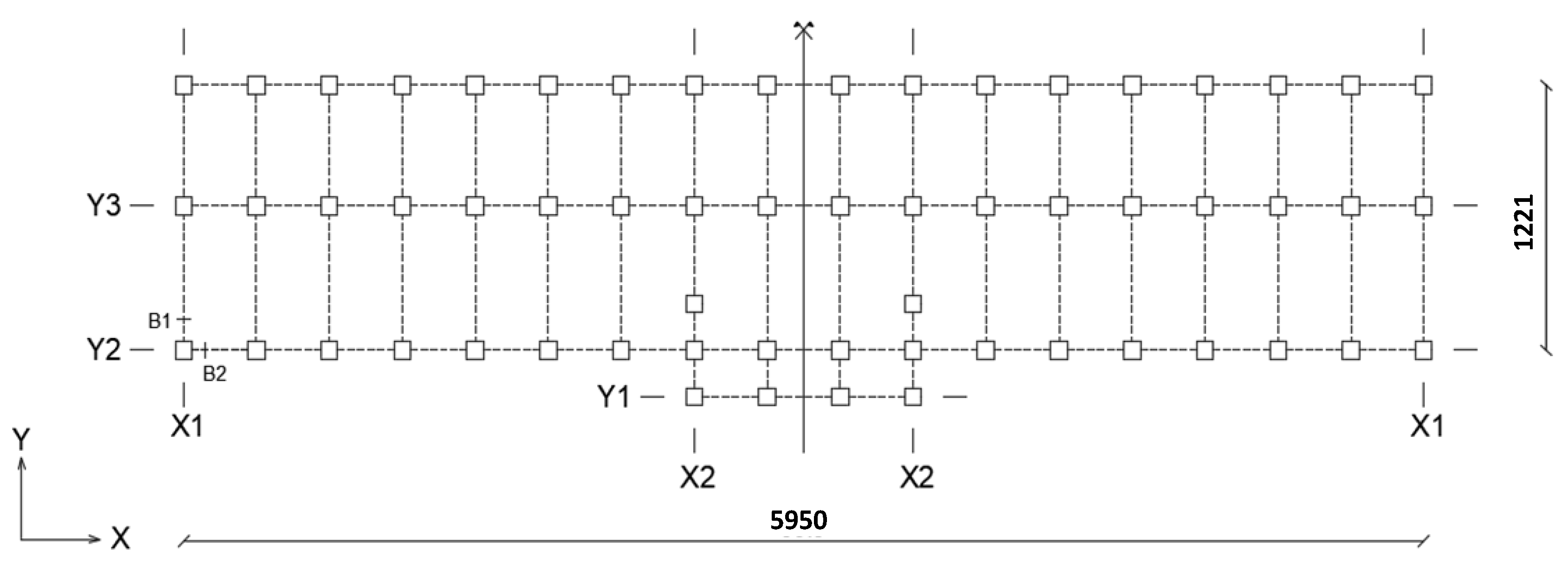
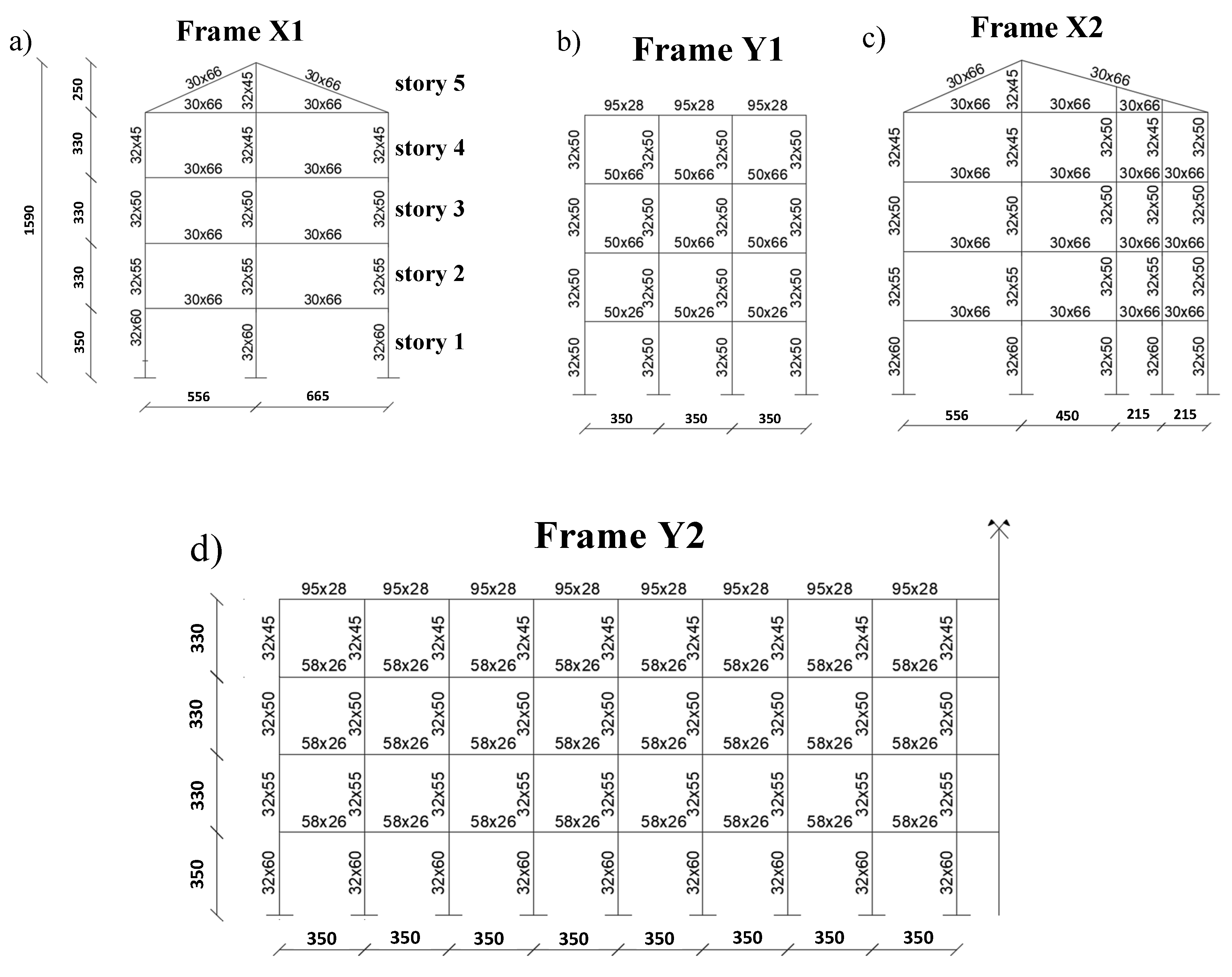
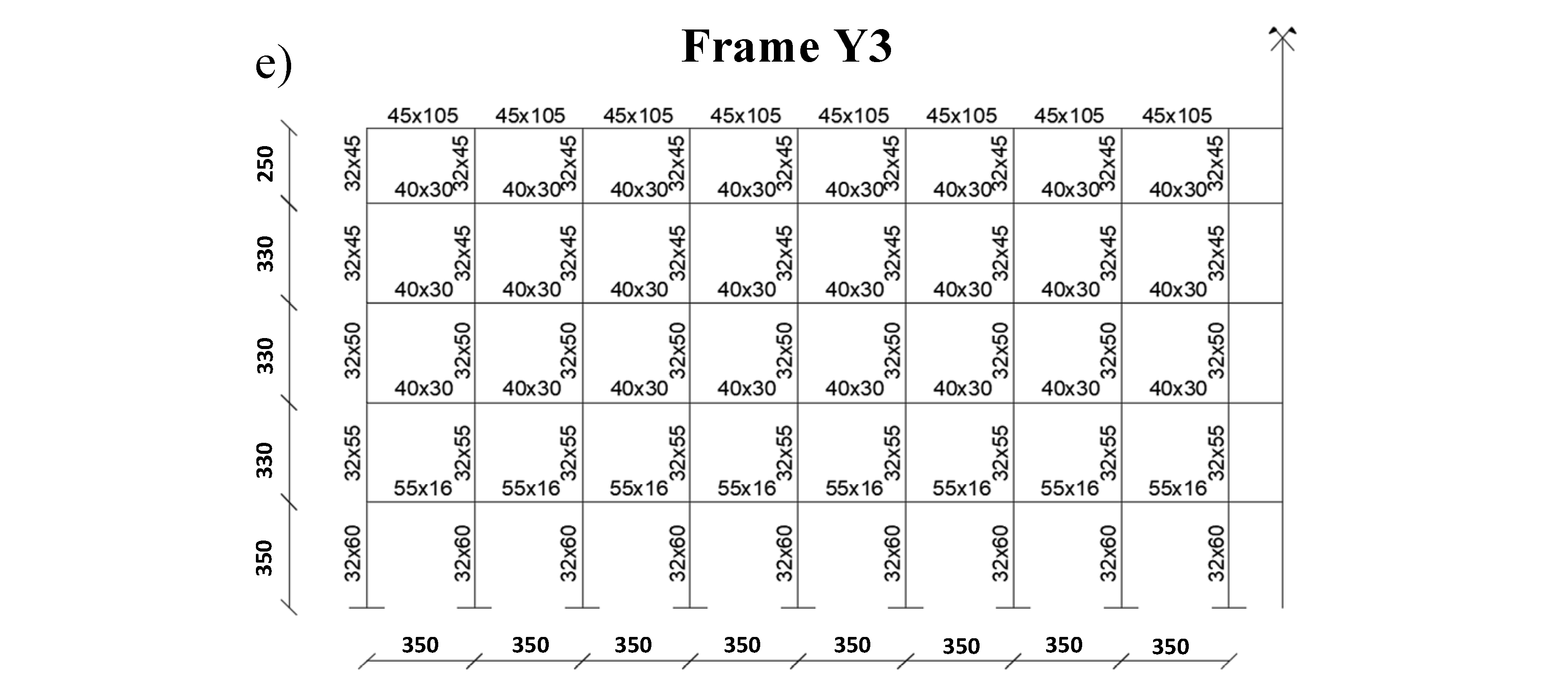






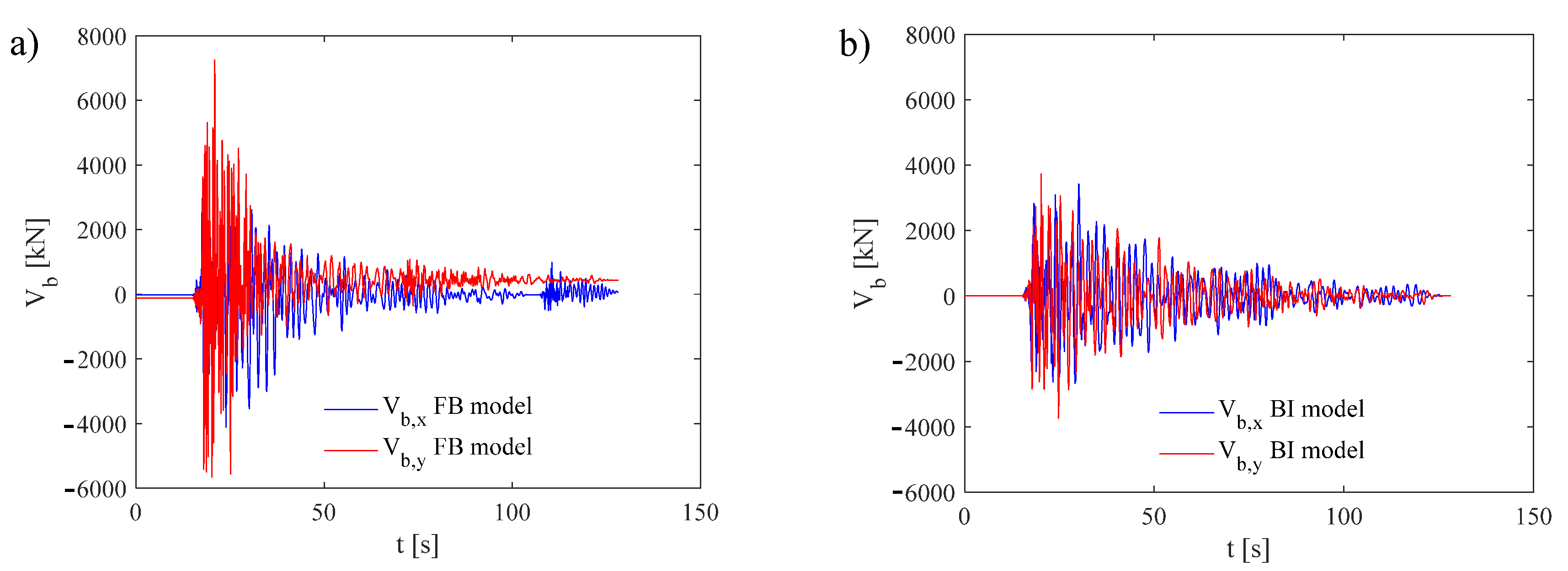
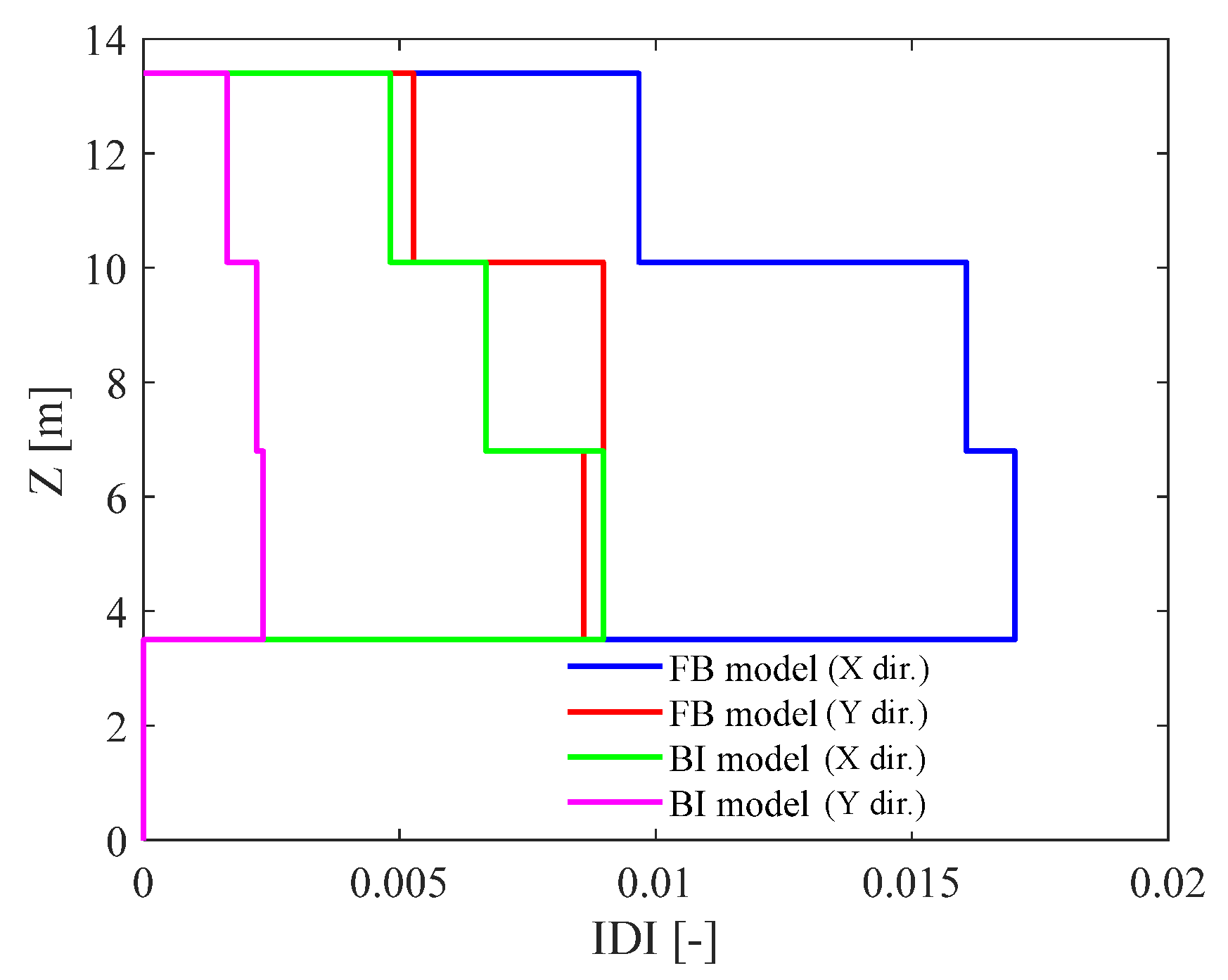
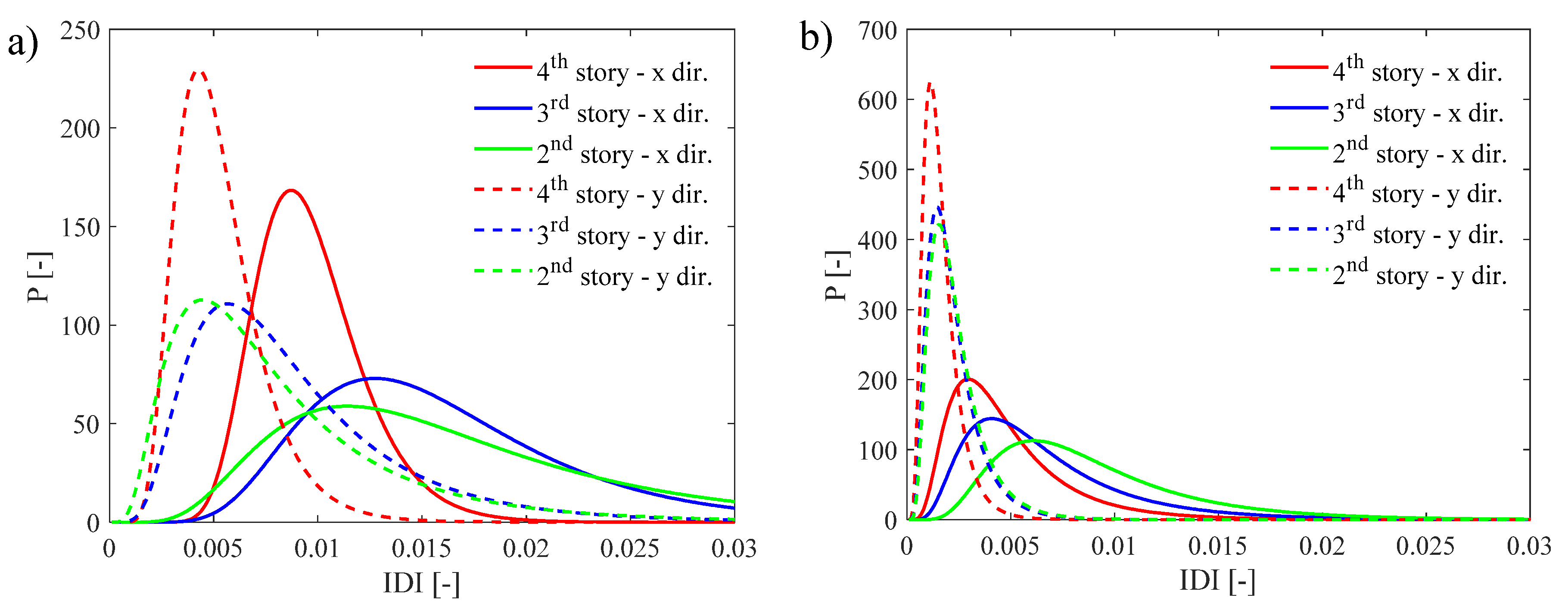

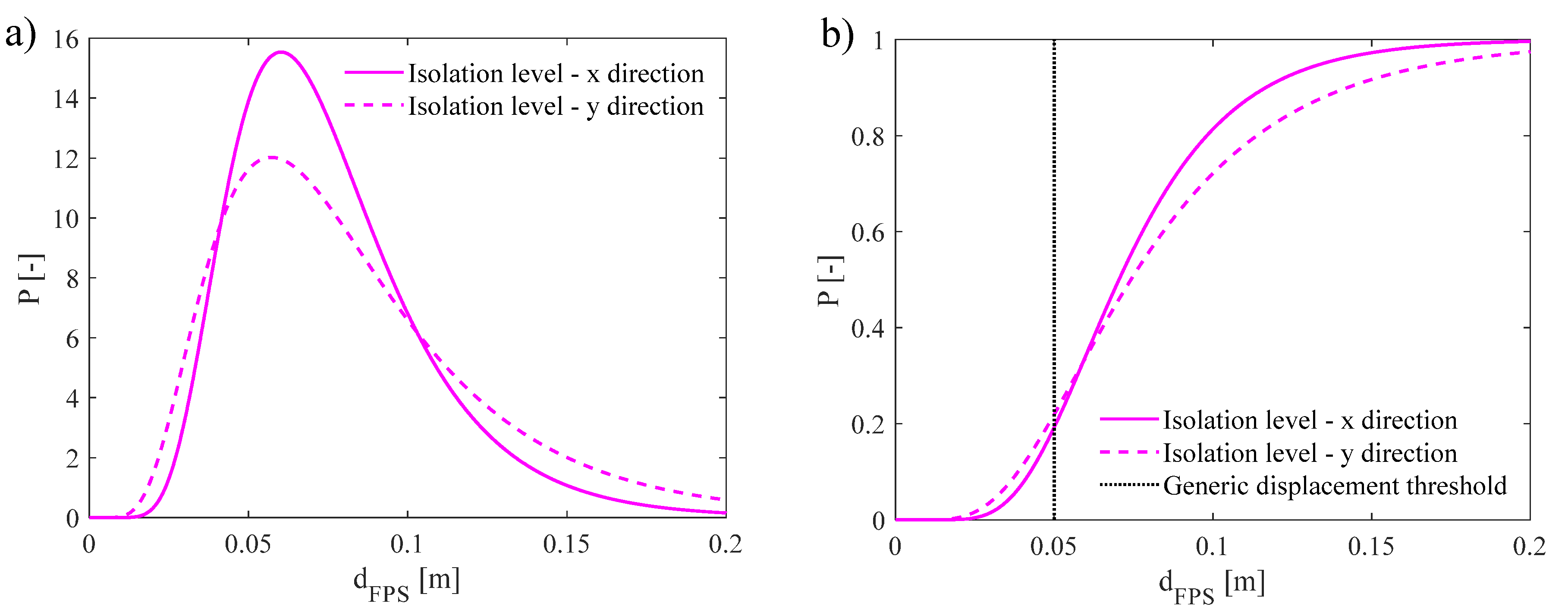
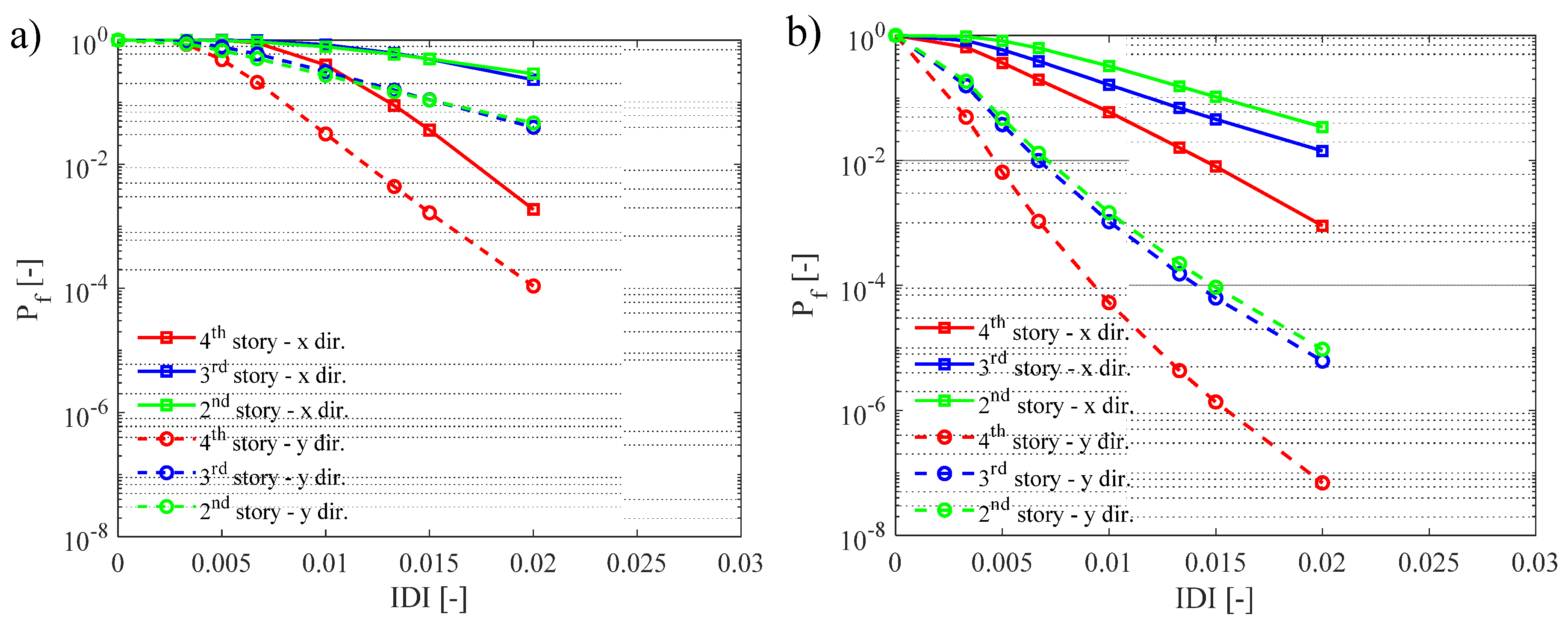
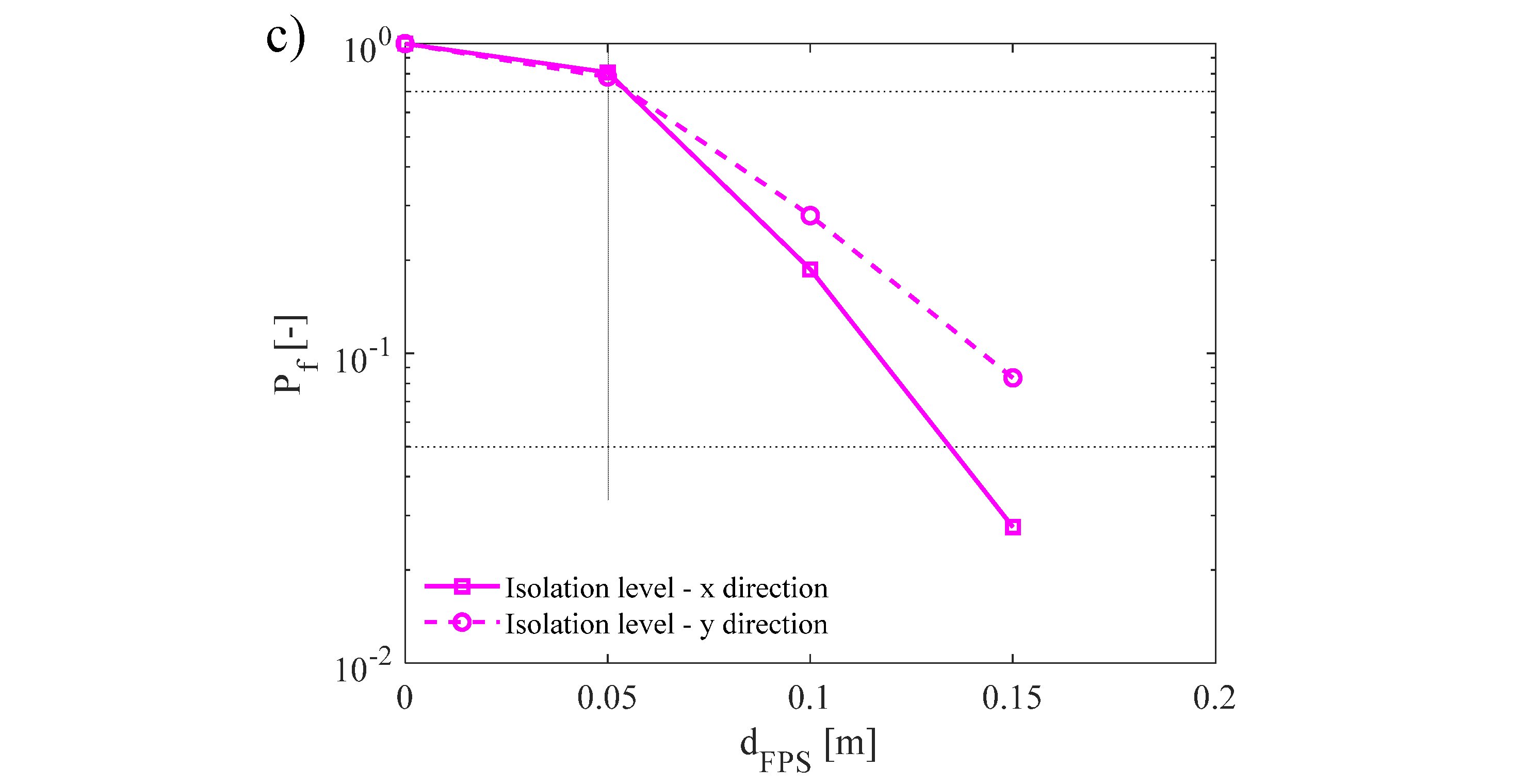
| Structural Member | Longitudinal Reinforcement | Shear Reinforcement | Longitudinal Reinforcement | Shear Reinforcement |
|---|---|---|---|---|
| Story | 1 | 2 | ||
| Column type 1 | 2𝜙20 + 5𝜙16/2𝜙20 + 5𝜙16 | 𝜙6/8 mm (2 leg stirrups) | 2𝜙20 + 5𝜙16/2𝜙20 + 5𝜙16 | 𝜙6/8 mm (2 leg stirrups) |
| Column type 2 | ||||
| Column type 3 | 2𝜙20 + 5𝜙14/2𝜙20 + 5𝜙14 | 𝜙6/12 mm (2 leg stirrups) | 2𝜙20 + 5𝜙14/2𝜙20 + 5𝜙14 | 𝜙6/12 mm (2 leg stirrups) |
| Beam type 1 | Midspan: Top 2𝜙14 Bottom 5𝜙16 | 𝜙6/19 mm (2 leg stirrups) | Midspan: Top 2𝜙14 Bottom 5𝜙16 | 𝜙6/19 mm (2 legs stirrups) |
| Support: Top 2𝜙14 + 5𝜙20 Bottom 2𝜙16 | 𝜙6/10 mm (2 leg stirrups) | Support: Top 2𝜙14 + 5𝜙20 Bottom 2𝜙16 | 𝜙6/10 mm (2 leg stirrups) | |
| Beam type 2 | Midspan Top 2𝜙12 Bottom 5𝜙14 | 𝜙6/19 mm (2 leg stirrups) | Midspan Top 2𝜙12 Bottom 5𝜙14 | 𝜙6/19 mm (2 leg stirrups) |
| Support Top 2𝜙14 + 5𝜙20 Bottom 3𝜙16 | 𝜙6/10 mm (2 leg stirrups) | Support Top 2𝜙14 + 5𝜙20 Bottom 3𝜙16 | 𝜙6/10 mm (2 leg stirrups) | |
| Beam type 3 | Top 2𝜙10 + 2𝜙12 Bottom 2𝜙10 + 2𝜙12 | 𝜙6/30 mm (2 leg stirrups) | Top 4𝜙10 Bottom 2𝜙10 + 2𝜙12 | 𝜙6/30 mm (2 leg stirrups) |
| Beam type 4 | Top 4𝜙10 Bottom 4𝜙10 | 𝜙6/30 mm (2 leg stirrups) | Top 4𝜙10 Bottom 4𝜙10 | 𝜙6/30 mm (2 leg stirrups) |
| Beam type 5 | Top 4𝜙14 Bottom 4𝜙14 | 𝜙6/10 mm (2 leg stirrups) | Top 4𝜙14 Bottom 4𝜙14 | 𝜙6/10 mm (2 leg stirrups) |
| Story | 3 | 4 | ||
| Column type 1 | 2𝜙20 + 5𝜙14/2𝜙20 + 5𝜙14 | 𝜙6/10 mm (2 leg stirrups) | 2𝜙20 + 5𝜙14/2𝜙20 + 5𝜙14 | 𝜙6/12 mm (2 leg stirrups) |
| Column type 2 | ||||
| Column type 3 | 𝜙6/12 mm (2 leg stirrups) | |||
| Beam type 1 | Midspan: Top 2𝜙14 Bottom 5𝜙16 | 𝜙6/19 mm (2 leg stirrups) | Midspan: Top 2𝜙14 Bottom 5𝜙16 | 𝜙6/19 mm (2 leg stirrups) |
| Support: Top 2𝜙14 + 5𝜙20 Bottom 2𝜙16 | 𝜙6/10 mm (2 legs stirrups) | Support: Top 2𝜙14 + 5𝜙20 Bottom 2𝜙16 | 𝜙6/10 mm (2 legs stirrups) | |
| Beam type 2 | Midspan Top 2𝜙12 Bottom 5𝜙14 | 𝜙6/19 mm (2 legs stirrups) | Midspan Top 2𝜙12 Bottom 5𝜙14 | 𝜙6/19 mm (2 legs stirrups) |
| Support Top 2𝜙14 + 5𝜙20 Bottom 3𝜙16 | 𝜙6/10 mm (2 legs stirrups) | Support Top 2𝜙14 + 5𝜙20 Bottom 3𝜙16 | 𝜙6/10 mm (2 legs stirrups) | |
| Beam type 3 | Top 3𝜙10 Bottom 2𝜙10 + 1𝜙12 | 𝜙6/30 mm (2 legs stirrups) | Top 4𝜙10 + 2𝜙12 Bottom 2𝜙10 | 𝜙6/30 mm (2 legs stirrups) |
| Beam type 4 | Top 4𝜙10 Bottom 4𝜙10 | 𝜙6/30 mm (2 legs stirrups) | Top 4𝜙10 Bottom 4𝜙10 | 𝜙6/30 mm (2 legs stirrups) |
| Beam type 5 | Top 4𝜙14 Bottom 4𝜙14 | 𝜙6/10 mm (2 legs stirrups) | Top 4𝜙10 + 1𝜙12 Bottom 2𝜙10 + 1𝜙12 | 𝜙6/10 mm (2 legs stirrups) |
| Story | 5 (Roof) | |||
| Beam type 6 | Top 2𝜙16 + 5𝜙20 Bottom 3𝜙16 + 2𝜙14 | 𝜙6/10 mm (2 legs stirrups) | ||
| Beam type 7 | Top 4𝜙10 Bottom 2𝜙12 + 2𝜙10 | 𝜙6/10 mm (2 legs stirrups) | ||
| FPS | |||||||||
|---|---|---|---|---|---|---|---|---|---|
| Type 1 | Type 2 | Type 3 | Type 4 | Type 5 | Type 6 | Type 7 | Type 8 | Type 9 | |
| R [m] | 1.5 | 1.5 | 1.5 | 1.5 | 1.5 | 1.5 | 1.5 | 1.5 | 1.5 |
| K2 [kN/m] | 355 | 442 | 471 | 293 | 413 | 400 | 431 | 335 | 382 |
| K1 [kN/m] | 18,080 | 22,517 | 23,996 | 14,957 | 21,038 | 20,381 | 21,958 | 17,093 | 19,460 |
| Earthquake Event | Date | M [-] | Fault Mechanism | D [km] |
|---|---|---|---|---|
| EQ1—Bingol | 05/01/2003 | 6.3 | Strike-slip | 11.79 |
| EQ2—Christchurch | 06/13/2011 | 6 | Reverse | 5.1 |
| EQ3—Darfield | 09/03/2010 | 7.1 | Strike-slip | 13.31 |
| EQ4—E Off Izu Peninsula | 05/03/1998 | 5.5 | Reverse | 9.5 |
| EQ5—EMILIA_Pianura_Padana | 05/29/2012 | 6 | Reverse | 4.73 |
| EQ6—Friuli 4th shock | 09/15/1976 | 5.9 | Reverse | 16.83 |
| EQ7—Hector Mine | 10/16/1999 | 7.1 | Strike-slip | 28.61 |
| EQ8—Honshu | 08/10/1996 | 5.9 | Reverse | 13.89 |
| EQ9—Hyogo-Ken Nanbu | 01/16/1995 | 6.9 | Strike-slip | 16.6 |
| EQ10—Landers | 06/28/1992 | 7.3 | Strike-slip | 13.08 |
| EQ11—L’Aquila mainshock | 04/06/2009 | 6.3 | Normal | 5.65 |
| EQ12—Loma Prieta | 10/18/1989 | 6.9 | Oblique | 27.59 |
| EQ13—Mid Niigata Prefecture | 10/23/2004 | 6.6 | Reverse | 16.42 |
| EQ14—Mt. Fuji Region | 03/15/2011 | 5.9 | Strike-slip | 12.8 |
| EQ15—N. Miyagi Prefecture | 07/25/2003 | 6.1 | Reverse | 9.93 |
| EQ16—Northridge | 01/17/1994 | 6.7 | Reverse | 20.19 |
| EQ17—Off Noto Peninsula | 03/25/2007 | 6.7 | Reverse | 6.64 |
| EQ18—Olfus | 05/29/2008 | 6.3 | Strike-slip | 8.25 |
| EQ19—South Iceland | 06/17/2000 | 6.5 | Strike-slip | 5.25 |
| EQ20—Southern Iwate Prefecture | 06/13/2008 | 6.9 | Reverse | 23.08 |
| EQ21—W. Tottori Prefecture | 10/06/2000 | 6.6 | Strike-slip | 11.78 |
Publisher’s Note: MDPI stays neutral with regard to jurisdictional claims in published maps and institutional affiliations. |
© 2020 by the authors. Licensee MDPI, Basel, Switzerland. This article is an open access article distributed under the terms and conditions of the Creative Commons Attribution (CC BY) license (http://creativecommons.org/licenses/by/4.0/).
Share and Cite
Gino, D.; Anerdi, C.; Castaldo, P.; Ferrara, M.; Bertagnoli, G.; Giordano, L. Seismic Upgrading of Existing Reinforced Concrete Buildings Using Friction Pendulum Devices: A Probabilistic Evaluation. Appl. Sci. 2020, 10, 8980. https://doi.org/10.3390/app10248980
Gino D, Anerdi C, Castaldo P, Ferrara M, Bertagnoli G, Giordano L. Seismic Upgrading of Existing Reinforced Concrete Buildings Using Friction Pendulum Devices: A Probabilistic Evaluation. Applied Sciences. 2020; 10(24):8980. https://doi.org/10.3390/app10248980
Chicago/Turabian StyleGino, Diego, Costanza Anerdi, Paolo Castaldo, Mario Ferrara, Gabriele Bertagnoli, and Luca Giordano. 2020. "Seismic Upgrading of Existing Reinforced Concrete Buildings Using Friction Pendulum Devices: A Probabilistic Evaluation" Applied Sciences 10, no. 24: 8980. https://doi.org/10.3390/app10248980
APA StyleGino, D., Anerdi, C., Castaldo, P., Ferrara, M., Bertagnoli, G., & Giordano, L. (2020). Seismic Upgrading of Existing Reinforced Concrete Buildings Using Friction Pendulum Devices: A Probabilistic Evaluation. Applied Sciences, 10(24), 8980. https://doi.org/10.3390/app10248980









